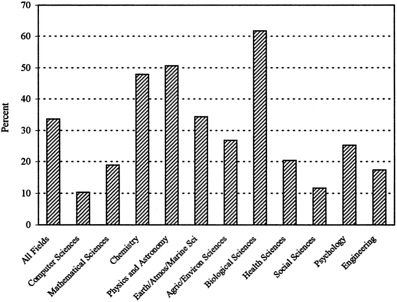4
POSTDOCTORAL APPOINTMENTS
This chapter examines the postdoctoral appointment 5 (postdoc) as a component of the career of doctoral scientists and engineers. Discussed here will be the total number of postdocs held, the postdoctoral status of the population in 1995, characteristics of those on postdocs in 1995, reasons for holding postdocs, and the relevance of the postdoc to the principal job held in 1995.
Number of Postdocs
-
Overall, 34 percent of science and engineering doctorates had held at least one postdoc and 9 percent had held multiple postdocs since award of the doctorate. Ph.D.s in the biological sciences were most likely to have held at least one postdoc (62 percent). Roughly half of those in chemistry and physics/astronomy also had held at least one postdoc. Least likely were doctorates in computer sciences and social sciences (10 and 12 percent, respectively). Biological sciences Ph.D.s were also most likely to have held multiple postdocs (20 percent) (see Table 25 ).
FIGURE 11. Proportion of science and engineering Ph.D.s having at least one postdoctoral appointment, by field, 1995.


